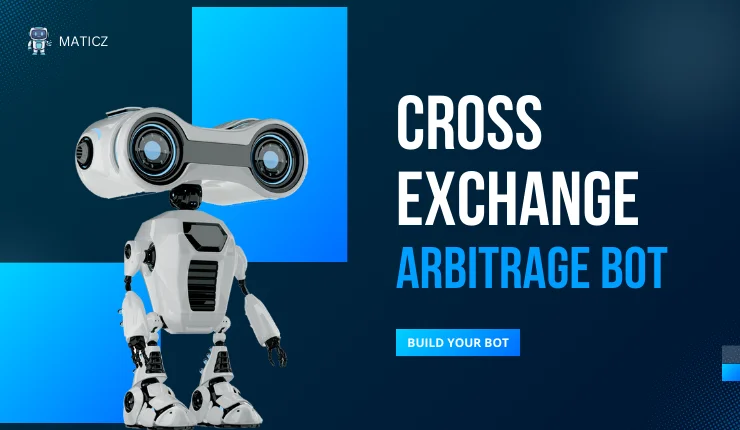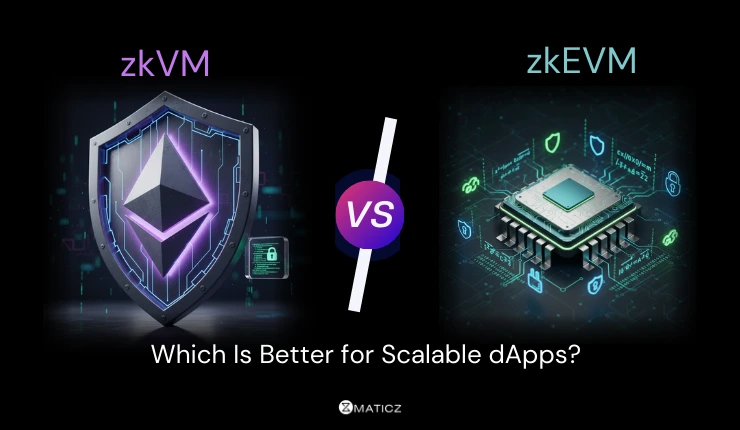Share Posts

What is Cross Exchange Arbitrage Bot and How to Develop it?
46
4591
103
The Term “Arbitrage” stands out with a certain approach that has the potential to make lucrative profits from the incapabilities of the market in the rapidly growing crypto trading world. This is a trading strategy that involves the purchase and sale the digital assets in many marketplaces simultaneously. At the same time, it gains profit from short-lived price discrepancies.
Here this blog describes one of the trendiest bots in the arbitrage universe which is - Cross Exchange Arbitrage. And let’s see the detailed version about its key factors, opportunities, and steps to create a Cross-Exchange Crypto Bot and more., Stay tuned! and Let’s dive into the topic.,
What is a Cross Exchange Arbitrage Bot?
Cross Exchange Arbitrage is simply called Simple Arbitrage. It is also known as Triangular arbitrage or cross-currency arbitrage. This Arbitrage is a trading process that involves purchasing the user’s desired cryptocurrencies at a low price or that is convenient for the user in one exchange (For example Binance) and selling that asset into another crypto exchange (For example Kraken) which offers a high price for the particular cryptocurrency. The primary goal of this cross-exchange crypto arbitrage bot is to gain profit from price fluctuations that can occur temporarily.
Cross-Exchange Crypto Arbitrage Bot Development
Cross-exchange arbitrage bot development represents a combination of cutting-edge technologies and economic innovation. This cross-exchange arbitrage uses algorithms to find the price fluctuation of cryptocurrency across various crypto exchanges instantly.
This makes it possible for traders to take advantage of these opportunities quickly. Because of their ability to automate processes and increase profit potential, these cross-currency arbitrage bots can execute trades so faster and when compared to humans more effectively.
Most Importantly, this Cross Exchange Arbitrage Bot Development implies a multi-faceted approach, because of the implementation of data analysis, blockchain technology, and algorithmic trading. With the help of complex algorithms, this cross-exchange currency bot can monitor a vast range of crypto exchanges simultaneously analyze the order books, and execute transactions at exactly the right time.
Types of Cross Currency Arbitrage Bot
In this arbitrage world, various types of crypto arbitrage rely on how this arbitrage is done. Let’s see the most common bot types among crypto investors:
Let’s split these Cross Exchange Crypto Arbitrage Bot into three categories:
1. Standard Arbitrage
2. Spatial Arbitrage
3. Decentralized Arbitrage
Standard Arbitrage
This type of Cross-Exchange Arbitrage involves buying and selling cryptocurrencies on two exchanges to profit from essential price discrepancies at any minute. It takes advantage of price volatility to make a quick profit. Let’s understand this cross-exchange arbitrage strategy better through an example of the most popularized exchanges - KuCoin and Binance.
Let’s look at the Price of Bitcoin in both KuCoin and Binance Exchanges.
The Price of Bitcoin (BTC) Price in Binance - $21,200
The Price of Bitcoin (BTC) Price in KuCoin - $21,000
In this type of Cross-Exchange Trading, we already explained that purchasing 1 BTC on Binance at a low price ($21,000) and selling cryptocurrency at a high price on KuCoin ($21,200). So that traders can get a risk-free profit of $200 minus trading fees. Moreover, this has to be done quickly, as the price differences even out in nanoseconds. Also, many pro-traders use this trendiest cross-exchange crypto arbitrage to robotize their strategies and gain lucrative profits.
Spatial Arbitrage
Spatial Cross Exchange Arbitrage Bot is another version of the previously mentioned arbitrage called Standard Arbitrage. Along with one small twist - The crypto exchanges are located in various regions. Let’s see, for instance, Korean crypto exchanges always have crucial price rewards due to the hype among regional traders towards certain tokens.
In July 2023, Curve Finance (CRV), DeFi's protocol's liquidity pools in Bithumb at 600% and Upbit on 55% continuously. The opportunity for such spatial arbitrage was obvious when trading at a higher premium.
Decentralized Arbitrage
Decentralized Arbitrage occurs when the price of the desired cryptocurrencies on a decentralized Automated Market Maker (AMM) market differs from the spot market on regular crypto exchange tremendously.
Rather than order books, decentralized exchanges use automated market makers to trade in a Decentralized mode. The AMM in decentralized exchange sets asset prices in each liquidity pool by analyzing its internal supply and how it balances with its trading pairs. This indicates that the price of an AMM changes automatically according to demand within its closed ecosystem.
Because the closed DeFi atmosphere and its situation affect the price, you can capitalize on price differences by buying a cryptocurrency on a decentralized exchange and selling it on a centralized exchange or vice versa. This type of arbitrage is a more particular subset of cross-exchange arbitrage trading.
How Does Cross-Exchange Arbitrage Bot Work?
The Cross-Exchange Arbitrage Bot replicates several important key processes. Each fundamental for its effectiveness in leveraging market inefficiencies:
Data Accumulation and Analysis
Cross-Exchange Arbitrage Bot gathers real-time data such as information on order books, price suppliers, and trading volume from various crypto exchanges. This data is analyzed by sophisticated algorithms to find price variations for the same asset across crypto exchanges.
Opportunity Detection
After researching and collecting data, these Cross-exchange bots find arbitrage opportunities by examining the values of particular pairs of cryptocurrencies across multiple crypto exchanges. It looks for price differences that show profit potential to go above pre-determined limits.
Risk Management
Managing risk is crucial for reducing potential losses from arbitrage trading. The Implementation of risk management protocols to account for key aspects like transaction fees, slippage, and market volatility that estimate the trade's exceptional size and ensure trades are executed within reasonable risk parameters.
Trade Execution
After identifying a profitable arbitrage opportunity, Proficient arbitrage traders execute trades across relevant exchanges rapidly and effectively. It uses cutting-edge order execution algorithms to render rapid execution while reducing the risk of price fluctuation during the trading process.
Portfolio Balancing
In addition, the Cross Exchange bot may also optimize the overall portfolio by rebalancing assets to maintain desired risk-return profiles to execute individual arbitrage trades. This includes customizing the allocation of funds around various crypto pairs and exchanges based on market situations and trading opportunities.
Monitoring and Reporting
During the process of trading, these Cross-Exchange arbitrage bots monitor the condition and the efficiency of trade execution of the crypto market constantly. It provides trader with real-time data and analytics, that permit them to readily monitor their arbitrage activities and determine the profitability of their plans.
Alteration and Enhancement
This kind of bot is an ongoing process that requires frequent modification and improvement. The developers of this arbitrage bot continuously modify the algorithms to accommodate for variations in trading strategies, exchange APIs, and market dynamics. This ensures that the Cross-Exchange Bot is more efficient at captivating arbitrage opportunities.
How to Develop a Cross-Exchange Arbitrage Bot?
Developing a Cross-Exchange Bot involves several crucial aspects that aid business owners who want to develop cross-currency arbitrage to get a clear idea about the development process. Let's go over the steps involved in creating a Cross-Exchange arbitrage bot in chronological order.
Choosing the Tech Stack
When choosing a tech stack, various aspects play a significant role that impacts the performance of cross-currency arbitrage bot, compatibility with APIs in Crypto exchange, scalability, and overall efficiency.
It is important to prioritize the tech stack or we can say tech language that is useful for the bot’s performance, speed, efficiency, performance after integrating the bot into a crypto exchange, and scalability for future enhancement. Continually saying, robust community support for resources, in-built security features, and easy management via syntax and troubleshooting abilities. Think of this type of aspect when the trader prefers the right tech stack for Cross Currency Arbitrage Development.
Data Collection and Architecture of Arbitrage
The architecture of such a cross-exchange bot includes multi-key factors that include a data collection system from various crypto exchanges, real-time data processing abilities, responsible algorithms for determining opportunities in arbitrage, strategies for seamless trading across various management protocols, and scalable features that play a most vital role to develop a structure to assure highly-effective cross-exchange arbitrage operations.
Integration of Cross-Exchange Bot Features
One of the crucial steps of cross-exchange bot development is to integrate important features into the exchange bot. This stage involves key features such as real-time data feeds from numerous exchanges, cutting-edge analytical tools for market trend analysis, risk management to mitigate potential losses, order execution, and much more.,
Other important aspects incorporate backtesting functionalities, API integrations with exchanges, and scrutinizing tools for performance valuation.
Testing Process of Cross-Exchange Arbitrage Trading
Testing includes managing extensive backtesting using historical data to assess the bot's performance under various market conditions. In addition, stress testing is important to evaluate the response of cross-exchange bots to high-volume trading and extreme market conditions, while security testing assures the resilience of cross-currency arbitrage bots against potential susceptibilities or cyber threats.
Testing the Cross-Exchange bot thoroughly across various scenarios can assist in identifying and addressing any issues or incapabilities, improving its capability and reliability for thriving trading outcomes ultimately.
Deploy the Cross Exchange Trading Bot
The Deployment process of the cross-exchange arbitrage involves setting up a bot on servers or cloud-based platforms that configure it to interlink with APIs and initiate live trading operations.
Once the deployment process is complete, it is necessary to monitor activities simultaneously, and performance metrics, and execute the trade of the trading bot to track its effectiveness and make required adjustments. Regular updates and maintenance are important to keep the cross-exchange arbitrage aligned with market movements and optimize its performance eventually.
Create your own Cross-Exchange Arbitrage Bot
Creating a cross-exchange arbitrage bot is quite a complex thing but rewarding attempt that integrates aspects of developing software, algorithmic trading, and crypto proficiency. By following the highlighted steps tech enthusiasts can build an enlightened tool that can identify and exploit arbitrage opportunities throughout multiple crypto exchanges, eventually enlarging the profitability of trading.
By leveraging cutting-edge technologies and data analysis strategies, these kinds of bots can capitalize on market price volatility that renders traders with highly valuable opportunities to generate coherent earnings.
Maticz is a leading Crypto trading bot development company that develops impeccable cross-exchange arbitrage bots. Our tech enthusiasts have real-world experience by creating a robust cryptocurrency trading bot that is strengthened with leading-edge features to deliver avant-garde performance.
If you want to integrate a crypto trading bot into your prevailing cryptocurrency exchange, Or else you want to develop a new crypto exchange along with a cross-exchange arbitrage bot, We Maticz offers you pre-fabricated solutions that assist startups and entrepreneurs in meeting their business aspirations. Then why wait? Join us to discuss your requirements for cross-exchange arbitrage bot.
Tap Into the Future
The latest insights, posts, and project updates - straight to your inbox.




